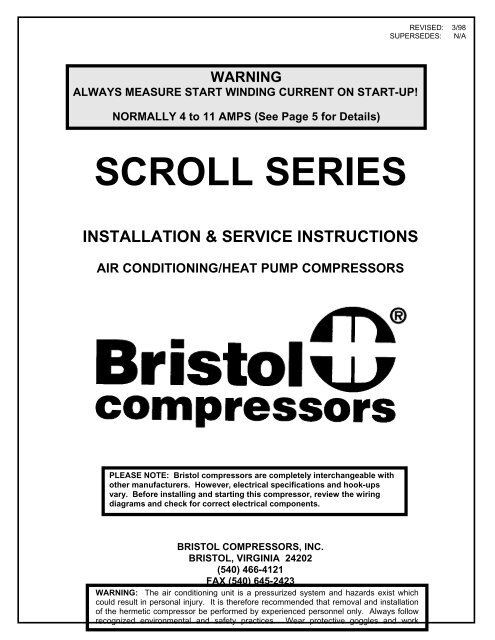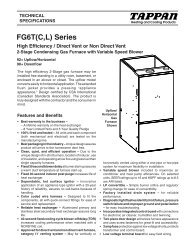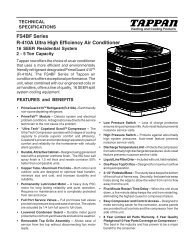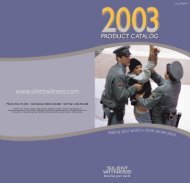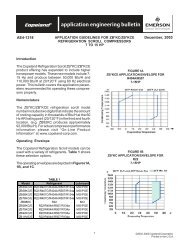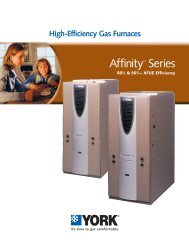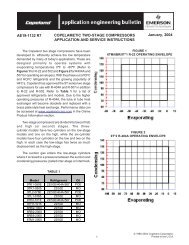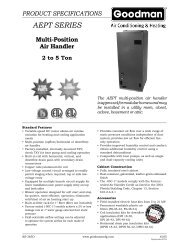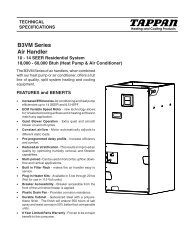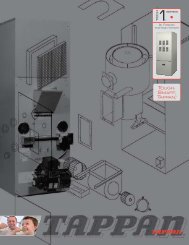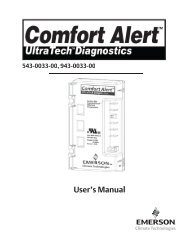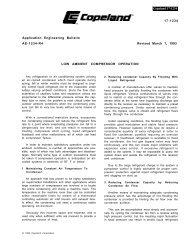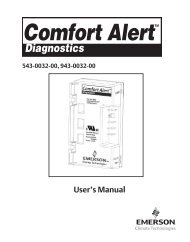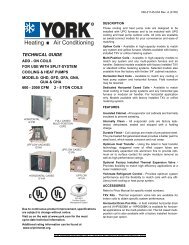Bristol Scroll Compressors - Desco Energy
Bristol Scroll Compressors - Desco Energy
Bristol Scroll Compressors - Desco Energy
- No tags were found...
You also want an ePaper? Increase the reach of your titles
YUMPU automatically turns print PDFs into web optimized ePapers that Google loves.
REVISED: 3/98SUPERSEDES: N/AWARNINGALWAYS MEASURE START WINDING CURRENT ON START-UP!NORMALLY 4 to 11 AMPS (See Page 5 for Details)SCROLL SERIESINSTALLATION & SERVICE INSTRUCTIONSAIR CONDITIONING/HEAT PUMP COMPRESSORSPLEASE NOTE: <strong>Bristol</strong> compressors are completely interchangeable withother manufacturers. However, electrical specifications and hook-upsvary. Before installing and starting this compressor, review the wiringdiagrams and check for correct electrical components.BRISTOL COMPRESSORS, INC.BRISTOL, VIRGINIA 24202(540) 466-4121FAX (540) 645-2423WARNING: The air conditioning unit is a pressurized system and hazards exist whichcould result in personal injury. It is therefore recommended that removal and installationof the hermetic compressor be performed by experienced personnel only. Always followrecognized environmental and safety practices. Wear protective goggles and workl
.WARNING: Never use oxygen to pressurize a refrigeration or air conditioning system.Oxygen can explode on contact with oil and could cause personal injury. When using highpressure gas such as nitrogen or CO 2 for this purpose, be sure to use a regulator that cancontrol the pressure down to 1 or 2 psig.The following instructions are general but include major points of consideration that will ensure proper installation andprotect you from possible personal injury. Please use this as a checklist, taking each item in its order before proceedingto the next. If more information is required, please call <strong>Bristol</strong> <strong>Compressors</strong> Service Department.1. VERIFY PROPER APPLICATION. Verify that the compressor being replaced and the <strong>Bristol</strong> compressorhave a like capacity for the refrigerant being used and that the voltage and frequency characteristics arethe same. Consult your wholesaler if you have any questions about proper compressor application.WARNING:To avoid electrical shock, power to the compressor should remain off duringperformance of Steps 2 thru 9.2. DETERMINE CAUSE OF INITIAL FAILURE. Double check system and associated controls to make surecompressor replacement is necessary. In order to prevent a second failure, the cause of the originalfailure must be determined. Identify the cause and make the necessary repairs. This may requirethorough system monitoring after the replacement is installed and running.A. BEFORE REMOVING THE FAULTY COMPRESSOR: Remove refrigerant charge using properrecovery procedures. <strong>Bristol</strong> scrolls have no process tubes. Access to the system is normallyachieved at the suction or discharge service valve or the access fittings in the low and/or high side ofthe system. If the system does not have access fittings, they should be installed. Because of the<strong>Bristol</strong> scrolls’ internal sealing ability, refrigerant must be recovered through both the high and lowside to avoid trapping refrigerant. Failure to do so could result in a hazardous condition if a torch isused to disconnect lines. Call 1-800-441-9450 for the name of the nearest Dupont authorizeddistributor, or 1-800-631-8138 for Genetron Representative or 1-800-ASK-KLEA (ICI) for informationon their refrigerant reclaim programs.B. Remove the electrical leads from the compressor. Note the terminal to which each wire is connected.C. During the next operation, the access ports should be open so that pressure does not build up in thesystem. If space permits, cut both the suction and discharge lines loose as close to compressor aspossible with tubing cutter. If sweating them loose is necessary, use a high temperature torch and beprepared to extinguish any remaining oil or refrigerant that may possibly ignite when lines aredisconnected.D. To assure excessive oil does not remain in the system, measure oil in failed compressor.Oil Charge Levels. <strong>Bristol</strong> <strong>Scroll</strong> compressors are charged with oil at the factory to the levelspecified on the code plate. For compressors using Refrigerant 22, the oil used is Zerol 150 with 3%Syn-O-Ad. If additional oil charge is added for in-service conditions, only Zerol 150 with Syn-O-Adshould be used. Oil levels can vary with different models and manufacturers. Refer to the individualmodel specification or consult your wholesaler to obtain this information.NOTE: If oil level is low, flush excess from system.CAUTION: The compressor may contain harmful acids ⎯ be sure to handle with extreme care usingproper protection equipment. After confirming oil charge level, return oil to the compressor. Thesuction and discharge copper tube fittings should be securely plugged or brazed closed. This isneeded to prevent further contamination of the compressor and to prevent spillage from thecompressor.3. MOUNT THE NEW COMPRESSOR. Do not remove dust cover or rubber shipping plugs until all otherconnections have been completed (i.e., filters installed and all tubing changes made ⎯ see steps 4 and 5).Compressor should not be open to the atmosphere for more than 15 minutes. Be sure to use the newPage 2
mounting grommets that were shipped with the compressor. If the mounting sleeves shipped with thecompressor are used, the mounting bolts will bottom out when tight. Use care not to over-compress themounting grommets when the mounting sleeves cannot be used.4. INSTALL FILTER DRIERS. <strong>Bristol</strong> <strong>Compressors</strong> recommends the use of adequately sized liquid andsuction line driers anytime a compressor is replaced. Assure the driers are compatible with the refrigerantused in the system. If the new compressor is used to replace a compressor with a burned motor, the useof a high acid neutralizing filter drier is recommended. For heat pumps, a suction filter drier must beinstalled between the accumulator and the compressor suction inlet. In addition, a bi-directionalheat pump liquid line drier or factory recommended driers must be installed. NOTE: ALWAYSREMOVE OLD FILTER DRIERS.5. BRAZE ON SUCTION AND DISCHARGE LINES. Flow an inert gas, such as nitrogen or CO 2 , through thesystem at approximately 2 psig. This will reduce the possibility of oxidation inside the tubing. Braze on thesuction and discharge lines.COPPER TUBING:BRAZING ALLOYS:If additional copper tubing is required, use only clean, dehydrated refrigerationgrade tubing with sealed ends. If a major change in tubing configuration ismade, the original system’s sound and vibration characteristics may be altered.Attention must be given to vibration, pressure drop, and interference.CAUTION: Do not use 95/5, 50/50 or 40/60 soft solder for brazing. Use Sil-Fos orPhos Copper, or similar brazing alloys with high tensile strength on copperwelds only. Weld steel to copper only with silver brazing alloys.BRAZING PROCEDURE: To ensure properly brazed joints, <strong>Bristol</strong> <strong>Compressors</strong> recommends that thefollowing procedure be used:Do not bend the discharge or suction lines or force the unit piping into thecompressor connections since this will increase stress and potential for failure.Tube Brazing1. Recommended brazing material: A 15% silver brazing material isrecommended for copper plated steel suction and discharge fittings.2. Clean the compressor tubing and system piping prior to assembly.3. A double-tipped torch is recommended during brazing.a. Apply heat to Area 1, moving the torch up and down and rotatingaround the tube in order to heat the tube evenly. It will become a dullorange color.b. Move the torch to Area 2 until it reaches a dull orange color. Move thetorch up and down and rotate it around tube in order to heat the tubeevenly.c. Add braze material to the joint while moving the torch around joint toflow braze material evenly around the circumference.Page 3
ASSURE CORRECT ROTATION. <strong>Bristol</strong> scroll compressors are designed to operate in one specificrotational direction. Reverse rotation can result in compressor damage and the following steps should betaken to minimize exposure to this condition.THREE PHASE motors will start and run in either direction depending on the phase relationship of thesupplied power. This requires special attention at start-up and the use of “phase monitors” to insure thecompressor is phased for proper rotation. Verification of proper rotation may be accomplished byobserving system pressures when the compressor is energized. Reverse rotation is indicated by adecrease in discharge pressure and an increase in suction pressure and possible noisy operation. Ifimproper rotation is allowed to continue, the compressor internal line break overload will shut thecompressor off. To correct the rotation, disconnect power and switch any two power leads at the unitcontactor. Never switch leads directly at the compressor.SINGLE PHASE (PSC) motors normally start and run in the correct direction and reverse rotation isgenerally not a concern. However, <strong>Bristol</strong> single phase scrolls may be forced into reverse direction, ifsubjected to a brief power interruption. At the initial interruption of power to the <strong>Bristol</strong> scroll, some of thehigh pressure refrigerant will flow back through the scrolls and cause the motor to rotate in the reversedirection. If, during this brief period of reverse rotation, power is re-applied, the compressor can operateunder power in a reverse direction. An internal check valve is employed to minimize the possibility of thisoccurring. As with the three phase, reverse operation is indicated by noisy operation, a decrease indischarge pressure and an increase in suction pressure. If reverse operation continues, the compressorinternal line break overload will shut the compressor off and when it resets, the compressor will start andoperate in the correct direction.To avoid reverse operation of the <strong>Bristol</strong> single phase scroll, a two minute off-cycle time delay relay (delayon break) should be installed in the control circuit. The time delay must be sensitive to momentary powerinterruptions. See diagram below.CONTROLSUPPLYVOLTAGEFUSETHERMOSTAT2 MINTIMEDELAYCH.P.L.P.COMPRESSORCONTACTORC 1CONDENSER FANCONTACTOR11. WORST CASE CONDITION CHECKS.HEAT PUMPSTEP 1: Operate system in the heating mode with outdoor fan disconnected.STEP 2: Run system until the designed winter condition in your area is reached (may need to cover coilfor this test).STEP 3: Check suction superheat 6" from compressor inlet.STEP 4: Superheat should not drop below 5°F (prefer no lower than 10°F).Page 6
STEP 5: Sump temperature should always be 50°F or higher above saturated suction temperature.EXAMPLE: "R-22"38 psig = 16°F = SATURATED SUCTION+ 50°F = MINIMUM TEMP. DIFFERENCE66°F = MINIMUM SUMP TEMPERATURECOOLING MODE (HEAT PUMP)STEP 1: Operate system in cooling mode with indoor fan disconnected and repeat steps 3, 4 and 5.AIR-CONDITIONING ONLY UNITSSTEP 1: Operate system in the cooling mode with indoor fan disconnected and repeat steps 3, 4 and 5.HOW TO CHECK SUPERHEAT58°FDIGITALTHERMOMETERTAKE SUCTIONTEMPERATURE10" TO 12"FROM COMPRESSORNOTE: 58° FFOR THE HARD TO GET-38° FTO COMPRESSOR TAKE20° FTEMPERATURES ANDPRESSURES HERE,AIR CONDITIONINGUNIT ONLYCONVERT SUCTIONPRESSURE TOTEMPERATURE65 PSIG = 38°FSUPERHEATCAUTION: <strong>Bristol</strong> scrolls can generate extremely low suction pressure, into low micron levelvacuum ranges, when the suction side of the compressor is closed or severely restricted. Thesevacuum ranges, when achieved, may cause internal arcing, resulting in a damaged or failedcompressor. Because of this characteristic, an operating <strong>Bristol</strong> scroll should never be functionallychecked by closing the suction service valve to test the pump down ability.12. CHECK FILTER DRIER FOR CONTAMINATION. If internal contamination is heavy, the suction line filterdrier may become clogged and ineffective. Check the pressure drop across the filter drier afterapproximately 8 hours running time and, if it exceeds 2 psig, replace.REVIEW ALL TWELVE STEPS TO MAKE SURE NOTHING WAS OVERLOOKED.Page 7
START ASSIST WIRING DIAGRAM (START AND RUN CAPACITORS):RUNCAPACITORPOTENTIALRELAYLINELINE2RCS15IDENTIFIEDTERMINALTO LINE SIDESTARTCAPACITORBLEEDRESISTORUse this diagram on systems with expansion valve and systems that don't allow pressure equalizationprior to compressor start.NOTE: WHEN CRANKCASE HEATER IS USED, CONNECT TO INCOMING POWER LINESO THAT HEATER IS ENERGIZED CONTINUOUSLY.PERMANENT SPLIT CAPACITOR (PSC) WIRING DIAGRAMLINERUNCAPACITORLINECRSIDENTIFIED TERMINALTO LINE SIDEUse this diagram on systems that allow pressure equalization prior to compressor start.NOTE: WHEN CRANKCASE HEATER IS USED, CONNECT TO INCOMING POWER LINESO THAT HEATER IS ENERGIZED CONTINUOUSLY.START ASSIST WIRING DIAGRAM (PTCR AND RUN CAPACITOR):LINERUNCAPACITORLINECRSIDENTIFIED TERMINALTO LINE SIDEUse this light start assist in case of a slight low voltage condition with equalized pressures prior tocompressor start.NOTE: LIGHT START ASSIST (PTCR) IS REQUIRED ON SOME HIGH EFFICIENCYCOMPRESSORS (SEE BOTTOM OF PAGE 9) EVEN WHEN THE SYSTEMEQUALIZES. NOT REQUIRED WHEN A START ASSIST KIT IS USED (RELAY,START CAPACITOR).Page 8
BRISTOL INFINITY/SCROLL TECHNOLOGIES ELECTRICAL COMPONENTSFOR SINGLE PHASE MODELSAdditional Model Specifications Available Upon RequestMODEL ELECTRICAL HIGH TORQUE COMPONENTSInfinity <strong>Scroll</strong> Voltage Hz Run Cap PTCR* Start Cap. GE PotentialTechnologiesRelayH20C233ABC SCD230AC01 230/208 60 35/370 Optional 88-108/250 3ARR3*9P*H20C303ABC SCD300AC01 230/208 60 35/440 Optional 88-108/250 3ARR3*10S*H20C343ABC SCD340AC01 230/208 60 35/440 Optional 88-108/250 3ARR3*25S*H20C373ABC SCD370AC01 230/208 60 35/440 Optional 88-108/250 3ARR3*6S*"C" SERIES9.1307.500.787 DIAMOUNTING HOLE3.750TYP (4)5.0679.1307.5004.1974.385H20C403ABC SCD400AC01 230/208 60 40/440 Optional 88-108/250 3ARR3*6S*H20C423ABC SCD420AC01 230/208 60 40/440 Optional 88-108/250 3ARR3*6S*2.77034°31°H20R453ABC SRD450AC01 230/208 60 50/440 Optional 88-108/250 3ARR3*25S*H20R483ABC SRD480AC01 230/208 60 50/440 Optional 88-108/250 3ARR3*25S*.504 I.D. DISCHARGEx .787 DEEP6.420 DIA1.050H20R583ABC SRD580AC01 230/208 60 55/440 Optional 88-108/250 3ARR3*25S*H20R603ABC SRD600AC01 230/208 60 55/440 Optional 88-108/250 3ARR3*25S*.755 I.D.SUCTIONx .787 DEEPH21R453ABC SRD450HC01 230/208 60 70/370 Optional 88-108/250 3ARR3*3L*H21R483CBC SRD480HC01 230/208 60 60/370 305C9 161-193/250 3ARR3*3L*H21R583CBC SRD580HC01 230/208 60 80/370 305C9 145-175/330 3ARR3*3P*H21R603CBC SRD600HC01 230/208 60 80/370 305C9 145-175/330 3ARR3*3P*H20C343ABK SCE340AC01 220/240 50 55/440 Optional 88-108/250 3ARR3*24AP*H20C373ABK SCE370AC01 220/240 50 55/440 Optional 88-108/250 3ARR3*24AP*SHH20C403ABK SCE400AC01 220/240 50 55/440 Optional 88-108/250 3ARR3*24AP*H20R453ABK SRE450AC01 220/240 50 55/440 Optional 88-108/250 3ARR3*24AP*H20R583ABK SRE580AC01 220/240 50 55/440 Optional 88-108/250 3ARR3*24AS*H20R603ABK SRE600AC01 220/240 50 55/440 Optional 88-108/250 3ARR3*24AS** Source for the PTCR 305 Series*Source for the crankcase heater"R" SERIES9.1307.500.787 DIAMOUNTING HOLE3.750TYP (4)5.4409.1307.5004.5604.765Ceramite Corporation1327 6th AvenueP. O. Box 166Grafton, WI 53024-0166Phone: (414) 377-3500Tutco, Inc.500 Gould DriveCookeville, TN 38506Phone: (615) 432-4141Part Number CH196 (240V/40 Watt)CH196-3 (480V/40 Watt)CH196-6 (575V/40 Watt)Fits “C” and “R” SeriesNOTE: All compressors with a “C” in the eighth digit of the model number require PTCRstart assist if start capacitor and relay are not used. PTCR start assist is optionalon models with “A” in the eighth digit. Refer to individual model specification forpart number..504 I.D. DISCHARGEx .787 DEEP2.77034°7.165 DIA31°1.050.881 I.D.SUCTIONx .803 DEEPHS.490GROUNDING SCREW RECOMMENDATIONS FOR “C” AND “R” SERIESHEX HEAD TAPPING SCREW-CORROSION RESISTANT STEELMetric Type “1” or Type “T”M5 x .8 . 12 mmEnglish Type “T”10-32 x ½ inchPage 9
PRESSURE-TEMPERATURE RELATION CHARTTEMPERATURE °F TEMPERATURE °FR404A R-407C R404A R-407CSaturated Saturated Saturated Saturated Saturated SaturatedPSIG R-22 R-502 R-12 134a Vap/Liq. Vapor Liquid PSIG R-22 R-502 R-12 134a Vap/Liq. Vapor Liquid5* -48 -57 -29 -22 -57 -41.0 -54.0 56 31 23 58 59 20 34.9 23.44* -47 -55 -28 -21 -56 -39.5 -52.6 58 32 24 60 60 22 36.4 24.93* -45 -54 -26 -19 -54 -38.1 -51.2 60 34 26 62 62 23 37.8 26.32* -44 -52 -25 -18 -53 -36.8 -49.8 62 35 27 64 64 25 39.2 27.81* -43 -51 -23 -16 -52 -35.5 -48.5 64 37 29 65 65 26 40.6 29.20 -41 -50 -22 -15 -50 -34.2 -47.2 66 38 30 67 66 27 42.0 30.61 -39 -47 -19 -12 -48 -31.8 -44.7 68 40 32 68 68 29 43.3 31.92 -44 -52 -25 -10 -46 -29.5 -42.3 70 41 33 70 69 30 44.6 33.33 -34 -42 -14 -8 -43 -27.2 -40.1 72 42 34 71 71 32 45.9 34.64 -32 -40 -11 -5 -41 -25.1 -37.9 74 44 36 73 72 33 47.8 36.55 -30 -38 -9 -3 -39 -23.1 -35.8 76 45 37 74 73 34 48.4 37.16 -28 -36 -7 -1 -37 -21.1 -33.8 78 46 38 76 75 35 49.6 38.47 -26 -34 -4 1 -35 -19.3 -31.9 80 48 40 77 76 37 50.8 39.68 -24 -32 -2 3 -33 -17.5 -30.1 85 51 43 81 79 40 53.7 42.69 -22 -30 0 5 -32 -15.7 -28.3 90 54 46 84 82 42 56.5 45.410 -20 -29 2 7 -30 -14.0 -26.6 95 56 49 87 85 45 59.2 48.211 -19 -27 4 8 -28 -12.4 -24.9 100 59 51 90 88 48 61.8 50.912 -17 -25 5 10 -27 -10.8 -23.3 105 62 54 93 90 50 64.3 53.513 -15 -24 7 12 -25 -9.2 -21.7 110 64 57 96 93 52 66.7 56.014 -14 -22 9 13 -23 -7.7 -20.1 115 67 59 99 96 55 69.1 58.415 -12 -20 11 15 -22 -6.3 -18.6 120 69 62 102 98 57 71.4 60.816 -11 -19 12 16 -20 -4.8 -17.2 125 72 64 104 100 59 73.6 63.017 -9 -18 14 18 -19 -3.5 -15.8 130 74 67 107 103 62 75.8 65.318 -8 -16 15 19 -18 -2.1 -14.4 135 76 69 109 105 64 77.9 67.519 -7 -15 17 21 -16 -0.8 -13.0 140 78 71 112 107 66 80.0 69.620 -5 -13 18 22 -15 0.5 -11.7 145 81 73 114 109 68 82.0 71.721 -4 -12 20 24 -14 1.8 -10.4 150 83 75 117 112 70 83.9 73.722 -3 -11 21 25 -12 3.0 -9.2 155 85 77 119 114 72 85.8 75.723 -1 -9 23 26 -11 4.2 -7.9 160 87 80 121 116 74 87.7 77.624 0 -8 24 27 -10 5.4 -6.7 165 89 82 123 118 76 89.5 79.525 1 -7 25 29 -9 6.6 -5.5 170 91 83 126 120 78 91.3 81.326 2 -6 27 30 -8 7.7 -4.3 175 92 85 128 122 80 93.1 83.227 4 -5 28 31 -6 8.9 -3.2 180 94 87 130 123 82 94.8 84.928 5 -3 29 32 -5 10.0 -2.1 185 96 89 132 125 83 96.5 86.729 6 -2 31 33 -4 11.0 -1.0 190 98 91 134 127 85 98.1 88.430 7 -1 32 35 -3 12.1 0.1 195 100 93 136 129 87 99.8 90.131 8 0 33 36 -2 -13.2 1.2 200 101 95 138 131 88 101.4 91.832 9 1 34 37 -1 14.2 2.2 205 103 96 140 132 90 102.9 93.433 10 2 35 38 0 15.2 3.3 210 105 98 142 134 92 104.5 95.034 11 3 37 39 1 16.2 4.3 220 108 101 145 137 95 107.4 98.135 12 4 38 40 2 17.2 5.3 230 111 105 149 140 98 110.3 101.136 13 5 39 41 3 18.1 6.3 240 114 108 152 143 101 113.1 104.137 14 6 40 42 4 19.1 7.2 250 117 111 156 146 104 115.9 106.938 15 7 41 43 5 20.0 8.2 260 120 114 159 149 107 118.5 109.739 16 8 42 44 6 20.9 9.1 275 124 118 163 153 111 122.3 113.740 17 9 43 45 7 21.8 10.1 290 128 122 168 157 115 126.0 117.642 19 11 45 47 8 23.6 11.9 305 132 126 172 161 118 129.5 121.344 21 13 47 49 10 25.4 13.6 320 136 130 177 165 122 132.9 124.946 23 15 49 51 12 27.1 15.4 335 139 133 181 169 126 136.2 128.448 24 16 51 52 14 28.7 17.0 350 143 137 185 172 129 139.4 131.850 26 18 53 54 16 30.3 18.7 365 146 140 188 176 132 142.5 135.052 28 20 55 56 17 31.9 20.354 29 21 57 57 19 33.4 21.9*Inches of MercuryNOTE: FOR REFRIGERANT BLENDS (R404A, R-407C)To determine superheat, use saturated vapor values (small figures)To determine subcooling, use saturated liquid values (BOLD figures)Page 10
N O T E SPage 11
200026EN Release E10403EN Revision E104033/98Page 12


